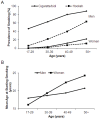A prospective study of tobacco smoking and mortality in Bangladesh
- PMID: 23505526
- PMCID: PMC3594295
- DOI: 10.1371/journal.pone.0058516
A prospective study of tobacco smoking and mortality in Bangladesh
Abstract
Background: Limited data are available on smoking-related mortality in low-income countries, where both chronic disease burden and prevalence of smoking are increasing.
Methods: Using data on 20,033 individuals in the Health Effects of Arsenic Longitudinal Study (HEALS) in Bangladesh, we prospectively evaluated the association between tobacco smoking and all-cause, cancer, and cardiovascular disease mortality during ∼7.6 years of follow-up. Cox proportional hazards models were used to estimate hazard ratios (HRs) and their 95% confidence intervals (CIs) for deaths from all-cause, cancer, CVD, ischemic heart disease (IHD), and stroke, in relation to status, duration, and intensity of cigarette/bidi and hookah smoking.
Results: Among men, cigarette/bidi smoking was positively associated with all-cause (HR 1.40, 95% CI 1.06 1.86) and cancer mortality (HR 2.91, 1.24 6.80), and there was a dose-response relationship between increasing intensity of cigarette/bidi consumption and increasing mortality. An elevated risk of death from ischemic heart disease (HR 1.87, 1.08 3.24) was associated with current cigarette/bidi smoking. Among women, the corresponding HRs were 1.65 (95% CI 1.16 2.36) for all-cause mortality and 2.69 (95% CI 1.20 6.01) for ischemic heart disease mortality. Similar associations were observed for hookah smoking. There was a trend towards reduced risk for the mortality outcomes with older age at onset of cigarette/bidi smoking and increasing years since quitting cigarette/bibi smoking among men. We estimated that cigarette/bidi smoking accounted for about 25.0% of deaths in men and 7.6% in women.
Conclusions: Tobacco smoking was responsible for substantial proportion of premature deaths in the Bangladeshi population, especially among men. Stringent measures of tobacco control and cessation are needed to reduce tobacco-related deaths in Bangladesh.
Conflict of interest statement
Figures


Similar articles
-
Effects of bidi smoking on all-cause mortality and cardiorespiratory outcomes in men from south Asia: an observational community-based substudy of the Prospective Urban Rural Epidemiology Study (PURE).Lancet Glob Health. 2017 Feb;5(2):e168-e176. doi: 10.1016/S2214-109X(17)30004-9. Lancet Glob Health. 2017. PMID: 28104186
-
Early health effects of the emerging tobacco epidemic in China. A 16-year prospective study.JAMA. 1997 Nov 12;278(18):1500-4. doi: 10.1001/jama.278.18.1500. JAMA. 1997. PMID: 9363969
-
Determinants of cigarette/bidi smoking among youth male in rural Mymensingh of Bangladesh: A cross-sectional study.PLoS One. 2020 Dec 28;15(12):e0244335. doi: 10.1371/journal.pone.0244335. eCollection 2020. PLoS One. 2020. PMID: 33370411 Free PMC article.
-
Cancer, cigarette smoking and premature death in Europe: a review including the Recommendations of European Cancer Experts Consensus Meeting, Helsinki, October 1996.Lung Cancer. 1997 May;17(1):1-60. doi: 10.1016/s0169-5002(97)00648-x. Lung Cancer. 1997. PMID: 9194026 Review.
-
Bidi smoking and oral cancer: a meta-analysis.Int J Cancer. 2003 Sep 10;106(4):600-604. doi: 10.1002/ijc.11265. Int J Cancer. 2003. PMID: 12845659
Cited by
-
Prevalence and Pattern of Smoking among Bus Drivers of Dhaka, Bangladesh.Tob Use Insights. 2014 Mar 9;7:21-5. doi: 10.4137/TUI.S13966. eCollection 2014. Tob Use Insights. 2014. PMID: 25741182 Free PMC article.
-
Assessment of concentration and toxicological (Cancer) risk of lead, cadmium and chromium in tobacco products commonly available in Bangladesh.Toxicol Rep. 2018 Aug 31;5:897-902. doi: 10.1016/j.toxrep.2018.08.019. eCollection 2018. Toxicol Rep. 2018. PMID: 30191134 Free PMC article.
-
Exercise Training Attenuates Cardiac Vulnerability and Promotes Cardiac Resistance to Isoproterenol-Induced Injury Following Hookah Smoke Inhalation in Male Rats: Role of Klotho and Sirtuins.Cardiovasc Toxicol. 2022 Jun;22(6):501-514. doi: 10.1007/s12012-022-09733-x. Epub 2022 Mar 22. Cardiovasc Toxicol. 2022. PMID: 35316495
-
Delphi study among international expert panel to develop waterpipe-specific health warning labels.Tob Control. 2020 Mar;29(2):159-167. doi: 10.1136/tobaccocontrol-2018-054718. Epub 2019 Jan 29. Tob Control. 2020. PMID: 30696784 Free PMC article.
-
Spatial distribution and contamination assessment of six heavy metals in soils and their transfer into mature tobacco plants in Kushtia District, Bangladesh.Environ Sci Pollut Res Int. 2016 Feb;23(4):3414-26. doi: 10.1007/s11356-015-5575-3. Epub 2015 Oct 21. Environ Sci Pollut Res Int. 2016. PMID: 26490917
References
-
- World Health Organization (2008) WHO Report on the Global Tobacco Epidemic, 2008: The MPOWER Package. WHO website. Available: http://whqlibdoc.who.int/publications/2008/9789241596282_eng.pdf. Accessed 2008.
-
- World Health Organization (1999) The World Health Report 1999. Making a Difference. WHO website. Available: http://www.who.int/whr/1999/en/index.html. Accessed 1999.
-
- Shihadeh A (2003) Investigation of mainstream smoke aerosol of the argileh water pipe. Food Chem Toxicol 41: 143–152. - PubMed
Publication types
MeSH terms
Grants and funding
LinkOut - more resources
Full Text Sources
Other Literature Sources
Medical

